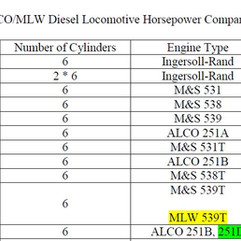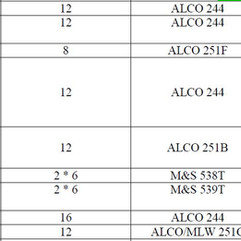ALCO Diesel Locomotive Horsepower Comparison
- bjlarosa96
- Mar 15, 2023
- 4 min read
Updated: Mar 17, 2023
In 2022, I created a couple of horsepower comparison charts listing all the diesel locomotives built by two of the largest manufacturers: Electro-Motive (EMD) and General Electric (GE Transportation). While both of them are still around, EMD became a subsidiary of Caterpillar’s Progress Rail in 2010 whereas GE Transportation merged with Wabtec Corporation nine years later. I’ve decided to make more charts representing other diesel builders that ultimately became defunct by the end of the 20th century. You’re about to experience the history of diesel power made by the American Locomotive Company, the second biggest manufacturer producing steam locomotives.
Widely known as ALCO, it was established in 1901 as a consolidation of eight steam builders. One of them was the Schenectady, New York Locomotive Works, which became the new company’s single plant as well as its headquarters. However, the Locomotive & Machine Company of Montreal, Quebec became the Canadian arm of ALCO and was renamed Montreal Locomotive Works (MLW). In 1905, ALCO was involved in the development of the very first practical diesel locomotive in the United States. The International Power Company supervised this project and required three different manufacturers to supply the major components. ALCO assembled a boxcab body, General Electric provided the electrical equipment, and the Corliss Steam Engine Co. manufactured a pair of four-cylinder diesel engines. The Southern Pacific Railroad was the first American customer of any diesel-electric locomotive.
The 1920’s turned out to be a successful decade for diesel development. A three-builder consortium was created to achieve this goal. Although ALCO and GE supplied the same locomotive components as what they did for the very first diesel mentioned earlier, the engines were manufactured by Ingersoll-Rand. Between 1924 and 1925, all three companies constructed five boxcab switchers (rated at 300 horsepower), the first of which was sold to the Central Railroad of New Jersey as number 1000. It would become the first diesel-electric locomotive with an excellent amount of performance, spending a total of 32 years in switching service. With its 1929 purchase of McIntosh & Seymour (M&S), an engine builder based in Auburn, New York, ALCO no longer required Ingersoll-Rand to manufacture its own diesel switchers. A six-cylinder M&S model 531 inline engine generated 600 horsepower for the “high hood” HH600 locomotive, known to be the first hood-style, end-cab diesel switcher in North America. The HH series was soon succeeded by the S-1 and S-2, both of which had 539-class engines housed in lower hoods.
When it comes to passenger duties, ALCO teamed up with the American Car & Foundry in 1935 to design the Rebel, a unique streamliner ordered by the Gulf, Mobile & Northern Railroad. The train’s power car was essentially equipped with the same 531-series engine used by the HH600 switcher. In 1940, ALCO introduced its first passenger diesel locomotive with standard railroad couplers as part of its DL series, which was the prelude to the graceful PA-1 that debuted after the Second World War. About a year later, the company developed a model that started the road switcher concept: the RS-1. It should be noted that between 1940 and 1953, ALCO partnered with General Electric again to produce and market mainline locomotives that would compete against the Electro-Motive Division of General Motors. Just after World War II officially ended, ALCO completed an experimental three-unit A-B-A diesel set (nicknamed “Black Maria”) to promote heavy mainline freight duties. Like the DL passenger diesels, the Black Maria had a similar nose design and was also the prelude to the FA-1, the four-axle freight version of the PA. The front-end nose was created by GE’s industrial designer Ray Patten for both the F and P cab units.
The American Locomotive Co. and Montreal Locomotive Works continued production of the diesel-powered S-series switchers and RS road switchers until the early 1960’s when the Century (C) line of hood units was announced. Unfortunately, ALCO had lost its good reputation in terms of reliability and was permanently closed by the end of the decade. However, MLW acquired the rights to build more ALCO-powered locomotives for several more years. The Century line was replaced by the “Montreal” line, as denoted by the letter M used on models built at that time. MLW initially continued to be an independent locomotive builder but soon became a division of Bombardier in 1975. The very last diesels were part of the short-lived “High Reliability” (HR) series and MLW had completely disappeared into history by the mid-1980’s. While ALCO turned out to be better at producing diesel locomotives than any other steam builder, it was not quite as good as Electro-Motive or General Electric. Despite their technical failures, ALCO’s diesels eventually became favorites of railroad fans and scale modelers in a world of more modern, high-tech locomotives built by EMD and GE.
As you view the horsepower comparison chart covering ALCO diesels, you’ll see a variety of engine types from the McIntosh & Seymour 500 series to the 200 series that bear the ALCO name. Additionally, some of the M&S models have the letter T for “turbocharged”. The 531, 538, and 539 types were used for the HH-series and early S-series switchers as well as the prewar DL passenger locomotives and the RS-1 road switcher. The 1,500-hp ALCO 241 was an experimental engine type that was used solely for the “Black Maria” freight demonstrator set. Due to its mechanical failures, the short-lived 241 was succeeded by the 244, which powered the P and F units and early RS hood units. The final engine model designed by ALCO was the 251. It consists of several variants with their letter suffixes ranging from A to G. The late FP units, the late switchers, the late RS units, the Century series, the Montreal series, and the Bombardier HR series were all built with 251 prime movers. Interestingly, the last two digits of each engine type represent an introduction year; for example, the 251 was first produced in 1951.
See if you can find the most powerful diesel-electric locomotive built by ALCO. Just follow along the horsepower ratings from the top to the bottom of the chart. Here are the screenshots snipped from this document, but you can also download a PDF copy of it for a full view. Click below to download the ALCO Horsepower Comparison chart. Good luck!









